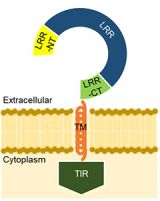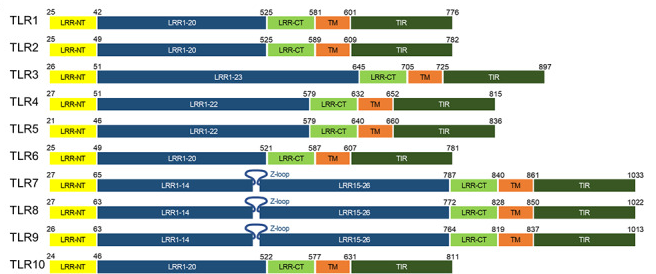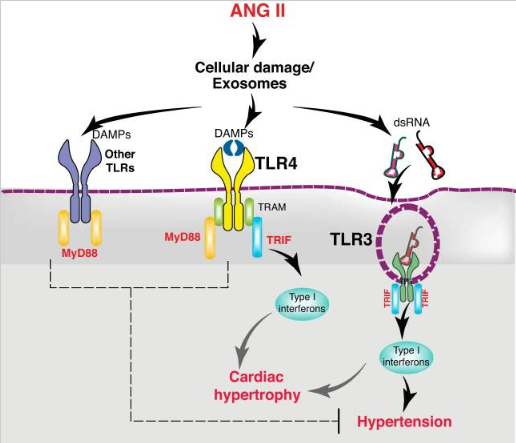双面守护者:解码Toll样受体在免疫与疾病中的关键角色
双面守护者:解码Toll样受体在免疫与疾病中的关键角色
1. Toll样受体家族简介
Toll样受体(TLR)是一组模式识别受体,在免疫系统的发育和维持中发挥着重要作用。这些受体可识别外来病原体相关分子模式(PAMP),以及细胞损伤的内源性副产物,即损伤相关分子模式(DAMP),通过TLR的信号传导导致促炎细胞因子和其他炎症反应介质的产生。因此,TLR及其信号通路对于先天免疫系统和适应性免疫系统的功能都至关重要。
1.1 TLR家族结构
TLR是I型跨膜蛋白,含有配体识别富含亮氨酸重复序列(LRR)结构域、跨膜结构域和Toll/白细胞介素1受体(TIR)同源结构域。LRR结构域负责配体识别,而细胞质TIR结构域通过与其衔接蛋白相互作用来启动下游信号级联反应。迄今为止,已在人类中鉴定出10个TLR(TLR1-10)。大多数TLR激活后以同源二聚体行使功能,但TLR2除外,TLR2与TLR1或TLR6以异二聚体形式行使功能。


图1 TLR的结构域示意图
(图片源于《Protein Sci》[1])
1.2 TLR家族分布
人类中的10个TLR在功能上分为两个亚组。一组由TLR1、TLR2、TLR4、TLR5、TLR6和TLR10组成,它们定位于细胞膜,主要识别脂质、脂蛋白和蛋白质等细菌成分。另一组由TLR3、TLR7、TLR8和TLR9组成,它们定位于内体/溶酶体,主要识别微生物核酸。TLR在多种造血细胞和非造血细胞中表达,包括效应免疫细胞(如树突状细胞、巨噬细胞、淋巴细胞、粒细胞)、造血干细胞和祖细胞以及非免疫细胞。
1.3 TLR信号传导途径
TLR的信号传导涉及细胞内衔接蛋白的募集,最终导致转录因子的激活以及促炎细胞因子的产生。除TLR3外,大多数活化的TLR招募MyD88和IRAK家族的成员(包括IRAK1、IRAK2和IRAK4)。这些蛋白质共同形成“Myddosome”。TRAF6随后被招募到该复合物中,刺激TAK1,随后激活NF-κB和MAPK通路,并产生促炎细胞因子。TLR3募集TRIF而不是MyD88,TLR4通过MyD88依赖性和TRIF依赖性两条途径传导信号。TRIF与TRAF3结合,然后招募TBK1和IKKε,从而激活IRF3并刺激I型干扰素的产生。此外,TRIF与TRAF6相互作用,促进NF-κB和MAPK通路的激活。

图2 TLR通过MyD88依赖性或TRIF依赖性途径传导信号
(图片源于《Cold Spring Harb Perspect Biol》[2])
2. TLR信号传导与癌症的相关研究
通过TLRs对免疫系统的外源性激活一方面可能是一种抗癌策略,但另一方面会加剧潜在的慢性炎症,这反过来又会进一步有利于癌症的进展。在慢性阻塞性肺疾病(COPD)背景下的K-ras突变小鼠中,敲除TLR2、TLR4或TLR9可降低肿瘤负荷、减少血管生成和肿瘤细胞增殖,并伴有肿瘤细胞凋亡增加和肿瘤微环境重新编程为抗肿瘤环境[3]。TLR9在前列腺癌(PCa)中高表达,与区域淋巴结受累和PCa侵袭性相关[4]。TLR4与PCa细胞系、肝细胞癌(HCC)增殖和侵袭能力以及低生存率相关,是革兰氏阴性肺炎增强的非小细胞肺癌(NSCLC)转移的可行治疗靶点[5-7]。阿霉素诱导的HMGB1释放会激活乳腺癌细胞中的TLR2信号传导,从而导致化疗耐药表型[8]。与此相反,TLR2通过激活细胞内在细胞周期停滞途径和促炎衰老相关分泌表型来抑制肺癌的早期进展[9]。TLR介导的PI3K激活通过产生半乳糖凝集素1调节卵巢癌的侵袭和转移[10]。抑制TLR信号传导可改善促炎细胞因子的产生并减少二乙基亚硝胺诱导的肝癌发生[11]。这些研究突出了TLR信号传导在癌症治疗中的潜在价值。

图3 TLR2依赖性化疗耐药机制的示意图
(图片源于《Oncoimmunology》[8])
3. TLR信号传导与心血管疾病的相关研究
TLR的激活在心血管疾病的发展、进展和结果中起着重要作用。TLR1、TLR2、TLR5、TLR6和TLR7通过增强巨噬细胞积累和T细胞反应性,调节病变和全身炎症促进动脉粥样硬化进展[12-15]。TLR2信号传导对于保护心脏免受小鼠衰老相关的不良重塑和收缩功能障碍至关重要[16]。ANG II诱导的高血压和心脏肥大与TLR4和TLR3的差异激活有关[17,18]。TLR9是高血压中血管周围脂肪组织功能障碍的关键介质,导致炎症、氧化应激和血管损伤[19]。研究显示TLR3是主动脉瓣钙化保守途径中的关键元素[20]。TLR4和MyD88之间的新型SNP相互作用与冠状动脉疾病风险增加相关[21]。TLR6通过氧化应激和炎症反应促进了心肌纤维化的进展[22]。这些研究表明更好地了解心血管疾病中TLR信号传导可能有助于开发靶向TLR的新疗法。

图4 ANG II对高血压和心脏肥大的差异效应模型示意图
(图片源于《Am J Physiol Heart Circ Physiol》[17])
4. TLR信号传导与肺部疾病的相关研究
由于肺部暴露于多种传染源、抗原和宿主来源的危险信号,肺部的基质细胞和髓系细胞表达TLR聚集体,这些TLR可以感知DAMP以及PAMP并触发涉及宿主防御的TLR相关信号传导。TLR1和TLR10基因的变异增加了毛细支气管炎后哮喘的风险[23],TLR7和TLR8可能赋予对哮喘的易感性[24]。TLR2和TLR4中的SNP与慢性阻塞性肺病(COPD)的严重程度和疾病进展相关[25],TLR7通过肥大细胞活性介导肺气肿和COPD[26]。抑制TLR2、TLR6、TLR3、TLR4介导的NF-κB和MAPK通路减轻肺炎支原体、LPS、抗体介导的输血相关的肺损伤和二氧化硅诱导的肺纤维化[27-32]。TLR4表达诱导炎症的持续激活,巨噬细胞病理性转移,是COVID-19致死的机制之一[33]。TLR5的抑制消除了囊性纤维化气道细胞在暴露于铜绿假单胞菌后产生的破坏性炎症反应[34]。肺挫伤后的损伤细胞通过TLR9激活急性炎症反应[35]。因此抑制TLR可能是肺损伤的新治疗策略。
5. TLR信号传导与炎症性肠病的相关研究
TLR作为肠道微生物群的传感器,在维持肠道稳态、控制免疫反应和塑造微生物群方面发挥着关键作用。TLR1、TLR2、TLR5和TLR6基因中的非同义变异与克罗恩病(CD)和溃疡性结肠炎(UC)之间存在关联[36,37]。ERS和TLR2在炎症性肠病(IBD)中上调,ERS可能促进TLR2通路介导的炎症反应[38]。抑制TLR2/NF-κB信号通路的激活可有效预防葡聚糖硫酸钠(DSS)诱导的IBD[39]。TLR3介导CCL20、CXCL10在结肠上皮细胞中的表达,参与IBD中的活动性炎症[40,41]。抑制TLR4/NF-κB/HIF-1α轴来增强UC治疗结局,从而减轻炎症反应,改善结肠病变[42,43]。激活TLR4/NF-κB通路加重DSS诱导的IBD的炎症和焦亡[44]。TLR6是肠道相关淋巴组织中Th1和Th17反应的重要驱动因素[45]。与前面这些研究相反,TLR3和TLR7识别驻留病毒介导的干扰素β产生改善肠道炎症[46],激活TLR9信号通路改善活动性UC患者的临床症状[47]。这些发现为靶向TLR信号传导治疗IBD提供帮助。

图5 TLR4/NF-κB/HIF-1α通路促进UC炎症的分子机制
(图片源于《Drug Des Devel Ther》[42])
6. TLR信号传导与神经退行性疾病的相关研究
TLR的激活能够诱导对中枢神经系统损伤或感染的免疫和炎症反应。靶向抑制TLR2、TLR4通路介导的神经炎症改善帕金森病的运动和认知障碍[48,49]。抑制TLR4/NF-κB信号通路可以通过抑制神经炎症和细胞凋亡来改善Aβ诱导的记忆功能障碍[50]。神经胶质细胞中TLR4信号传导增强促进肌萎缩侧索硬化症(ALS)小鼠的疾病进展[51]。microRNA和ssRNA可以充当信号分子,激活中枢神经系统中的TLR7信号传导,促进神经变性和神经炎症[52,53]。TLR9信号传导的激活会通过诱导氧化应激和炎症来加剧神经退行性变[54]。相反,另有研究表明TLR2作为骨髓来源免疫细胞的内源性受体有助于清除有毒Aβ;在TLR2缺乏的情况下,认知能力下降会显著加速[55]。因此,TLR可以作为开发神经保护药物的潜在药物病理学靶点。
云克隆助力科学研究,为广大科研人员提供相关检测试剂产品,相关靶标核心货号如下:
靶标 | 核心货号 | 靶标 | 核心货号 | 靶标 | 核心货号 |
BTK | B915 | JNK1 | B156 | RIPK2 | B786 |
CD14 | A685 | JNK2 | D576 | SARM1 | M182 |
CD36 | B530 | JunB | H765 | SIGIRR | M229 |
c-Jun | B292 | LY96 | H705 | TANK | J823 |
IFNa | A033 | MAP2K3 | D563 | TICAM1 | H022 |
IFNb | A222 | MAP2K4 | D564 | TICAM2 | H021 |
IkBa | B848 | MAP2K6 | B721 | TIRAP | N888 |
IkBb | B849 | MAP2K7 | D560 | TLR1 | B988 |
IkBe | E700 | MAP3K7 | D567 | TLR10 | B992 |
IkBKb | J822 | MAP3K7IP1 | L705 | TLR2 | A663 |
IkBKg | J820 | MAPK11 | B435 | TLR3 | B989 |
IKKA | K407 | MAPK12 | D577 | TLR4 | A753 |
IL1b | A563 | MAPK13 | D578 | TLR5 | B990 |
IL1RL1 | H820 | MAPK14 | B206 | TLR6 | A683 |
IL6 | A079 | MARCO | C614 | TLR7 | B950 |
IL8 | A080 | MSR1 | B591 | TLR8 | B991 |
IRAK1 | B514 | MyD88 | B707 | TLR9 | A709 |
IRAK2 | B515 | NFkB | B824 | TNFa | A133 |
IRAK3 | B520 | NFkB2 | B825 | TRAF3 | G753 |
IRAK4 | B518 | NFKB3 | A616 | TRAF6 | G751 |
IRF3 | B589 | RelB | B826 | TRAM1 | F824 |
IRF8 | B776 | RIPK1 | E640 |
更多科研试剂,欢迎访问云克隆官方网站:http://www.cloud-clone.cn/
参考文献
[1]Asami J, Shimizu T. Structural and functional understanding of the toll-like receptors. Protein Sci. 2021;30(4):761-772.
[2]Lim KH, Staudt LM. Toll-like receptor signaling. Cold Spring Harb Perspect Biol. 2013;5(1):a011247.
[3]Velasco WV, Khosravi N, Castro-Pando S, et al. Toll-like receptors 2, 4, and 9 modulate promoting effect of COPD-like airway inflammation on K-ras-driven lung cancer through activation of the MyD88/NF-ĸB pathway in the airway epithelium. Front Immunol. 2023;14:1118721.
[4]Kalantari E, Abolhasani M, Roudi R, et al. Co-expression of TLR-9 and MMP-13 is associated with the degree of tumour differentiation in prostate cancer. Int J Exp Pathol. 2019;100(2):123-132.
[5]Takahashi I, Takagi K, Yamaguchi-Tanaka M, et al. Toll-like receptor (TLR) 4 is a potent prognostic factor in prostate cancer associated with proliferation and invasion. Pathol Res Pract. 2024;260:155379.
[6]Liu WT, Jing YY, Yu GF, et al. Toll like receptor 4 facilitates invasion and migration as a cancer stem cell marker in hepatocellular carcinoma. Cancer Lett. 2015;358(2):136-143.
[7]Gowing SD, Chow SC, Cools-Lartigue JJ, et al. Gram-Negative Pneumonia Augments Non-Small Cell Lung Cancer Metastasis through Host Toll-like Receptor 4 Activation. J Thorac Oncol. 2019;14(12):2097-2108.
[8]Di Lorenzo A, Bolli E, Ruiu R, et al. Toll-like receptor 2 promotes breast cancer progression and resistance to chemotherapy. Oncoimmunology. 2022;11(1):2086752.
[9]Millar FR, Pennycuick A, Muir M, et al. Toll-like receptor 2 orchestrates a tumor suppressor response in non-small cell lung cancer. Cell Rep. 2022;41(6):111596.
[10]Park GB, Chung YH, Kim D. Induction of galectin-1 by TLR-dependent PI3K activation enhances epithelial-mesenchymal transition of metastatic ovarian cancer cells. Oncol Rep. 2017;37(5):3137-3145.
[11]Fan X, He C, Jing W, et al. Intracellular Osteopontin inhibits toll-like receptor signaling and impedes liver carcinogenesis. Cancer Res. 2015;75(1):86-97.
[12]Mullick AE, Tobias PS, Curtiss LK. Modulation of atherosclerosis in mice by Toll-like receptor 2. J Clin Invest. 2005;115(11):3149-3156.
[13]Curtiss LK, Black AS, Bonnet DJ, Tobias PS. Atherosclerosis induced by endogenous and exogenous toll-like receptor (TLR)1 or TLR6 agonists. J Lipid Res. 2012;53(10):2126-2132.
[14]Ellenbroek GH, van Puijvelde GH, Anas AA, et al. Leukocyte TLR5 deficiency inhibits atherosclerosis by reduced macrophage recruitment and defective T-cell responsiveness. Sci Rep. 2017;7:42688.
[15]Liu CL, Santos MM, Fernandes C, et al. Toll-like receptor 7 deficiency protects apolipoprotein E-deficient mice from diet-induced atherosclerosis. Sci Rep. 2017;7(1):847.
[16]Spurthi KM, Sarikhani M, Mishra S, et al. Toll-like receptor 2 deficiency hyperactivates the FoxO1 transcription factor and induces aging-associated cardiac dysfunction in mice. J Biol Chem. 2018;293(34):13073-13089.
[17]Singh MV, Cicha MZ, Nunez S, Meyerholz DK, Chapleau MW, Abboud FM. Angiotensin II-induced hypertension and cardiac hypertrophy are differentially mediated by TLR3- and TLR4-dependent pathways. Am J Physiol Heart Circ Physiol. 2019;316(5):H1027-H1038.
[18]Dange RB, Agarwal D, Masson GS, et al. Central blockade of TLR4 improves cardiac function and attenuates myocardial inflammation in angiotensin II-induced hypertension. Cardiovasc Res. 2014;103(1):17-27.
[19]Carvalho KFS, de Lima JF, Silva JLM, et al. Toll-like receptor 9 contributes to perivascular adipose tissue dysfunction in spontaneously hypertensive rats. Eur J Pharmacol. 2025;998:177524.
[20]Gollmann-Tepeköylü C, Graber M, Hirsch J, et al. Toll-Like Receptor 3 Mediates Aortic Stenosis Through a Conserved Mechanism of Calcification. Circulation. 2023;147(20):1518-1533.
[21]Sun D, Sun L, Xu Q, et al. SNP-SNP Interaction between TLR4 and MyD88 in Susceptibility to Coronary Artery Disease in the Chinese Han Population. Int J Environ Res Public Health. 2016;13(3):278.
[22]Zhang Y, Zhang Y. Toll-like receptor-6 (TLR6) deficient mice are protected from myocardial fibrosis induced by high fructose feeding through anti-oxidant and inflammatory signaling pathway. Biochem Biophys Res Commun. 2016;473(2):388-395.
[23]Korppi M, Törmänen S. Toll-like receptor 1 and 10 variations increase asthma risk and review highlights further research directions. Acta Paediatr. 2019;108(8):1406-1410.
[24]Møller-Larsen S, Nyegaard M, Haagerup A, Vestbo J, Kruse TA, Børglum AD. Association analysis identifies TLR7 and TLR8 as novel risk genes in asthma and related disorders. Thorax. 2008;63(12):1064-1069.
[25]Budulac SE, Boezen HM, Hiemstra PS, et al. Toll-like receptor (TLR2 and TLR4) polymorphisms and chronic obstructive pulmonary disease. PLoS One. 2012;7(8):e43124.
[26]Liu G, Haw TJ, Starkey MR, et al. TLR7 promotes smoke-induced experimental lung damage through the activity of mast cell tryptase. Nat Commun. 2023;14(1):7349.
[27]Ding N, Lei A, Shi Z, Xiang L, Wei B, Wu Y. Total Flavonoids from Camellia oleifera Alleviated Mycoplasma pneumoniae-Induced Lung Injury via Inhibition of the TLR2-Mediated NF-κB and MAPK Pathways. Molecules. 2023;28(20):7077.
[28]Fang X, Song T, Zheng L, et al. Targeting mast cell activation alleviates anti-MHC I antibody and LPS-induced TRALI in mice by pharmacologically blocking the TLR3 and MAPK pathway. Biomed Pharmacother. 2024;180:117456.
[29]Zhu Y, Han Q, Wang L, et al. Jinhua Qinggan granules attenuates acute lung injury by promotion of neutrophil apoptosis and inhibition of TLR4/MyD88/NF-κB pathway. J Ethnopharmacol. 2023;301:115763.
[30]Zhou J, Peng Z, Wang J. Trelagliptin Alleviates Lipopolysaccharide (LPS)-Induced Inflammation and Oxidative Stress in Acute Lung Injury Mice. Inflammation. 2021;44(4):1507-1517.
[31]Zhang Y, Liu F, Jia Q, et al. Baicalin alleviates silica-induced lung inflammation and fibrosis by inhibiting TLR4/NF-?B pathway in rats. Physiol Res. 2023;72(2):221-233.
[32]Zou M, Yang L, Niu L, et al. Baicalin ameliorates Mycoplasma gallisepticum-induced lung inflammation in chicken by inhibiting TLR6-mediated NF-κB signalling. Br Poult Sci. 2021;62(2):199-210.
[33]Pedicillo MC, De Stefano IS, Zamparese R, et al. The Role of Toll-like Receptor-4 in Macrophage Imbalance in Lethal COVID-19 Lung Disease, and Its Correlation with Galectin-3. Int J Mol Sci. 2023;24(17):13259.
[34]Blohmke CJ, Victor RE, Hirschfeld AF, et al. Innate immunity mediated by TLR5 as a novel antiinflammatory target for cystic fibrosis lung disease. J Immunol. 2008;180(11):7764-7773.
[35]Suresh MV, Thomas B, Dolgachev VA, et al. Toll-Like Receptor-9 (TLR9) is Requisite for Acute Inflammatory Response and Injury Following Lung Contusion. Shock. 2016;46(4):412-419.
[36]Pierik M, Joossens S, Van Steen K, et al. Toll-like receptor-1, -2, and -6 polymorphisms influence disease extension in inflammatory bowel diseases. Inflamm Bowel Dis. 2006;12(1):1-8.
[37]Sheridan J, Mack DR, Amre DK, et al. A non-synonymous coding variant (L616F) in the TLR5 gene is potentially associated with Crohn's disease and influences responses to bacterial flagellin. PLoS One. 2013;8(4):e61326.
[38]Wu W, Zhao Y, Hu T, et al. Endoplasmic reticulum stress is upregulated in inflammatory bowel disease and contributed TLR2 pathway-mediated inflammatory response. Immunopharmacol Immunotoxicol. 2024;46(2):192-198.
[39]Chen Y, Jin T, Zhang M, et al. Flavokawain B inhibits NF-κB inflammatory signaling pathway activation in inflammatory bowel disease by targeting TLR2. Toxicol Appl Pharmacol. 2024;486:116922.
[40]Skovdahl HK, Granlund Av, Østvik AE, et al. Expression of CCL20 and Its Corresponding Receptor CCR6 Is Enhanced in Active Inflammatory Bowel Disease, and TLR3 Mediates CCL20 Expression in Colonic Epithelial Cells. PLoS One. 2015;10(11):e0141710.
[41]Ostvik AE, Granlund AV, Bugge M, et al. Enhanced expression of CXCL10 in inflammatory bowel disease: potential role of mucosal Toll-like receptor 3 stimulation. Inflamm Bowel Dis. 2013;19(2):265-274.
[42]Li J, Dan W, Zhang C, et al. Exploration of Berberine Against Ulcerative Colitis via TLR4/NF-κB/HIF-1α Pathway by Bioinformatics and Experimental Validation. Drug Des Devel Ther. 2024;18:2847-2868.
[43]Zhu Z, Liao L, Gao M, Liu Q. Garlic-derived exosome-like nanovesicles alleviate dextran sulphate sodium-induced mouse colitis via the TLR4/MyD88/NF-κB pathway and gut microbiota modulation. Food Funct. 2023;14(16):7520-7534.
[44]Ma JP, Yao CZ, Jia ZQ, et al. TRIM52 aggravated inflammation and pyroptosis in dextran sulfate sodium-induced inflammatory bowel disease through activation of the TLR4/NF-κBs pathway. Allergol Immunopathol (Madr). 2023;51(1):159-167.
[45]Morgan ME, Koelink PJ, Zheng B, et al. Toll-like receptor 6 stimulation promotes T-helper 1 and 17 responses in gastrointestinal-associated lymphoid tissue and modulates murine experimental colitis. Mucosal Immunol. 2014;7(5):1266-1277.
[46]Yang JY, Kim MS, Kim E, et al. Enteric Viruses Ameliorate Gut Inflammation via Toll-like Receptor 3 and Toll-like Receptor 7-Mediated Interferon-β Production. Immunity. 2016;44(4):889-900.
[47]Atreya R, Bloom S, Scaldaferri F, et al. Clinical Effects of a Topically Applied Toll-like Receptor 9 Agonist in Active Moderate-to-Severe Ulcerative Colitis. J Crohns Colitis. 2016;10(11):1294-1302.
[48]Nemutlu Samur D, Akçay G, Yıldırım S, et al. Vortioxetine ameliorates motor and cognitive impairments in the rotenone-induced Parkinson's disease via targeting TLR-2 mediated neuroinflammation. Neuropharmacology. 2022;208:108977.
[49]Yang J, Jia M, Zhang X, Wang P. Calycosin attenuates MPTP-induced Parkinson's disease by suppressing the activation of TLR/NF-κB and MAPK pathways. Phytother Res. 2019;33(2):309-318.
[50]Chen L, Hu L, Zhao J, et al. Chotosan improves Aβ1-42-induced cognitive impairment and neuroinflammatory and apoptotic responses through the inhibition of TLR-4/NF-κB signaling in mice. J Ethnopharmacol. 2016;191:398-407.
[51]Lee JY, Lee JD, Phipps S, Noakes PG, Woodruff TM. Absence of toll-like receptor 4 (TLR4) extends survival in the hSOD1 G93A mouse model of amyotrophic lateral sclerosis. J Neuroinflammation. 2015;12:90.
[52]Lehmann SM, Krüger C, Park B, et al. An unconventional role for miRNA: let-7 activates Toll-like receptor 7 and causes neurodegeneration. Nat Neurosci. 2012;15(6):827-835.
[53]Lehmann SM, Rosenberger K, Krüger C, et al. Extracellularly delivered single-stranded viral RNA causes neurodegeneration dependent on TLR7. J Immunol. 2012;189(3):1448-1458.
[54]Iliev AI, Stringaris AK, Nau R, Neumann H. Neuronal injury mediated via stimulation of microglial toll-like receptor-9 (TLR9). FASEB J. 2004;18(2):412-414.
[55]Richard KL, Filali M, Préfontaine P, Rivest S. Toll-like receptor 2 acts as a natural innate immune receptor to clear amyloid beta 1-42 and delay the cognitive decline in a mouse model of Alzheimer's disease. J Neurosci. 2008;28(22):5784-5793.